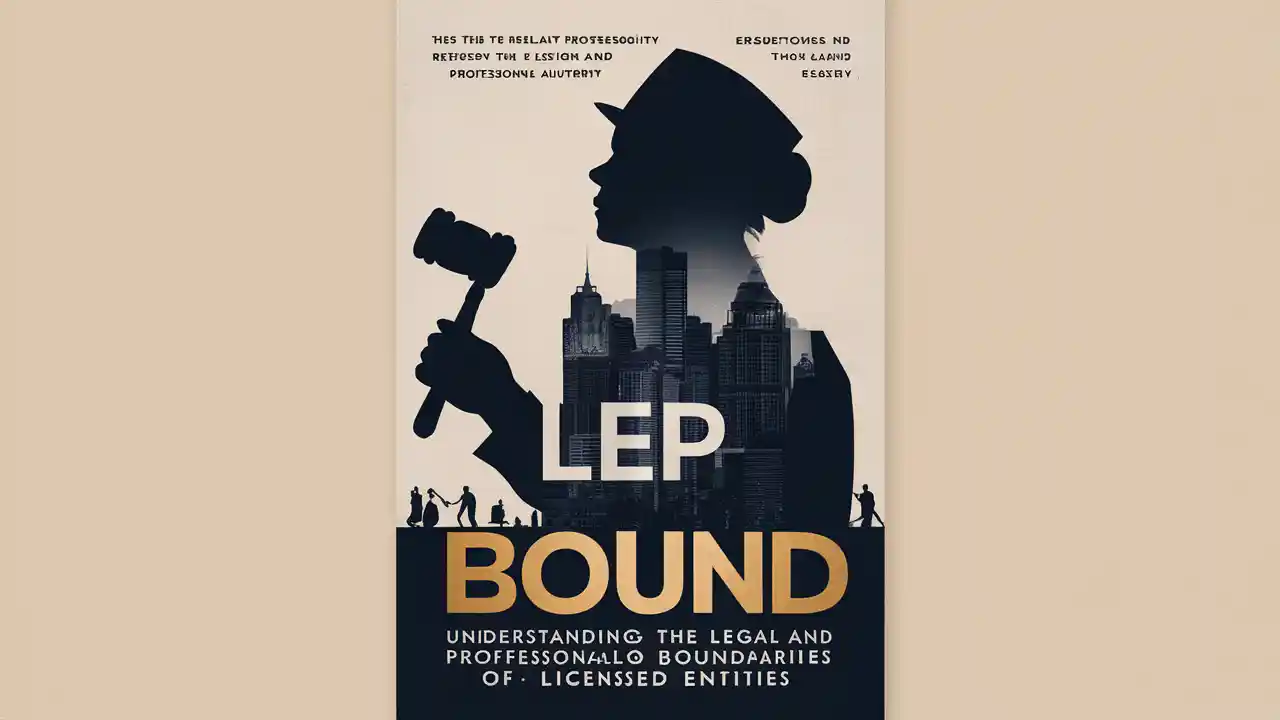In the complex and highly regulated worlds of law, healthcare, finance, and other licensed professions, practitioners often operate within a strict framework of permissible actions. The term Lep Bound has emerged as a concise, albeit informal, way to describe the state of being legally and ethically constrained by the rules of one’s licensing body. To be “Lep Bound” is to have one’s scope of practice, commercial activities, and even public statements delineated by a set of external regulations designed to protect the public and maintain the integrity of the profession. This concept is not merely about limitation; it is about defining the very field upon which a professional can play. Understanding the depth and nuance of what it means to be Lep Bound is crucial for any licensed individual, as ignorance of these boundaries is rarely considered a valid excuse for crossing them and can lead to severe disciplinary action, financial penalties, or the revocation of the right to practice. This article delves into the multifaceted nature of these professional boundaries, exploring their origins, their implications for daily practice, and strategies for ensuring unwavering compliance.
The Foundation of Being Bound: Origins and Governing Bodies
The constraints that make a professional Lep Bound do not materialize from nowhere; they are the product of meticulous legislation and the ongoing work of dedicated professional governing bodies. For attorneys, it is the state bar association; for physicians, the state medical board; for certified public accountants, the American Institute of CPAs (AICPA) and state boards of accountancy. These organizations are granted their authority by state law and are tasked with a dual mission: to safeguard the public interest and to elevate the standards of the profession they oversee. The rules they promulgate are comprehensive and often voluminous, covering everything from the specific services a professional is qualified to perform (e.g., a nurse practitioner versus a registered nurse) to the intricacies of client confidentiality, conflict of interest, advertising practices, and the management of client funds. This legal and ethical codex forms the absolute perimeter of a professional’s operation. Therefore, the first step for any licensed individual is to achieve a profound familiarity with the governing documents of their specific board. This foundational knowledge is the bedrock upon which a secure and reputable career is built, transforming the concept of being Lep Bound from a potential hindrance into a clear roadmap for professional conduct.
The Daily Reality of Operational and Ethical Constraints
The theoretical framework of professional regulations manifests in a hundred practical decisions made every day. For a healthcare professional, being Lep Bound means referring a patient to a specialist when their condition falls outside one’s own certified scope of practice, even if it means losing business. For a lawyer, it means rigorously maintaining client confidentiality and navigating conflicts of interest by conducting thorough checks before accepting a new case. In the financial realm, a Lep Bound accountant must adhere to strict independence standards, avoiding any investments or relationships that could compromise their objective judgment during an audit. These constraints also extend into the digital age, governing how professionals present themselves online, the claims they make in advertising, and their conduct on social media. A casual post offering generic legal advice could be construed as forming an attorney-client relationship, while a healthcare professional discussing a case online, even anonymously, could violate HIPAA regulations. The modern professional must therefore be vigilant not only in their formal client interactions but in all their public-facing activities, understanding that their license and reputation are perpetually on the line.
Navigating the Gray Areas: Interpretation and Risk Management
While many rules are black and white, a significant portion of being Lep Bound involves navigating ethical gray areas where the correct path is not immediately clear. Is it a conflict of interest to represent a client whose business competitor is a former client if the matters are unrelated? Can a financial advisor accept a small gift from a grateful client without it appearing to be a quid pro quo? In these ambiguous situations, the burden of interpretation falls on the professional. The most prudent strategy for managing this risk is to cultivate a practice of proactive consultation. This involves regularly discussing complex scenarios with seasoned colleagues, participating in continuing education courses on ethics, and, most importantly, seeking formal advisory opinions from the governing body itself. Many state bars and boards have mechanisms for professionals to propose a hypothetical situation and receive guidance on how to proceed without fear of penalty. This proactive engagement with the rules transforms the professional from a passive subject of regulation into an active participant in their own ethical practice, effectively managing the risks inherent in being Lep Bound.
Conclusion: Embracing the Framework for Professional Excellence
While the term Lep Bound might superficially suggest restriction, a deeper understanding reveals that these boundaries are, in fact, the very elements that define and empower a profession. They create a trusted standard that allows the public to engage with professionals—be they doctors, lawyers, or accountants—with confidence in their competence and ethics. This trust is the lifeblood of any licensed field. Rather than viewing these rules as chains that inhibit practice, the most successful professionals embrace them as a necessary framework that elevates their work above unlicensed competitors and reinforces their value to society. They understand that to be Lep Bound is to be part of a respected community with a sworn duty to uphold certain principles. By mastering these constraints, they do not limit their potential; they solidify their reputation, mitigate existential risks, and build a sustainable, honorable career on a foundation of integrity and public trust.
FAQ Section
Q1: What does “Lep” stand for in Lep Bound?
A: In the professional context, “Lep” is most commonly understood to be an abbreviation for “Licensed Entity Professional” or simply “Licensed Professional.” It’s an informal industry shorthand rather than a formal legal term.
Q2: Is being Lep Bound the same for every profession?
A: No, the specific rules and constraints vary dramatically between professions and even between states or countries. The scope of practice for a nurse is entirely different from that of an architect or a securities broker. Each profession has its own unique governing body and set of rules that define what it means to be bound within that field.
Q3: What are the consequences of violating my professional boundaries?
A: The consequences can be severe and are typically progressive. They can range from a private reprimand or a mandate for continuing education for minor infractions to public censure, heavy fines, mandatory supervision, suspension, and ultimately, the permanent revocation of your professional license. In cases involving criminal activity, it can also lead to civil and criminal penalties.
Q4: How can I stay updated on changes to the rules that bind my profession?
A: Proactive engagement is key. You should regularly review communications (newsletters, emails, websites) from your licensing board, commit to completing mandatory continuing education (which almost always includes ethics credits), join professional associations that offer updates and seminars, and network with colleagues to discuss evolving standards and interpretations.
Q5: Does the concept of “Lep Bound” exist in fantasy literature?
A: Yes, in a completely different context. In fantasy genres, “Lep” often refers to a Leprechaun or other mythical Fae creature. “Being bound” in this sense refers to a magical or contractual agreement with such a creature, often involving tricky terms, promises, or the granting of wishes. It’s a popular trope exploring themes of fate, magic, and the danger of deals.


